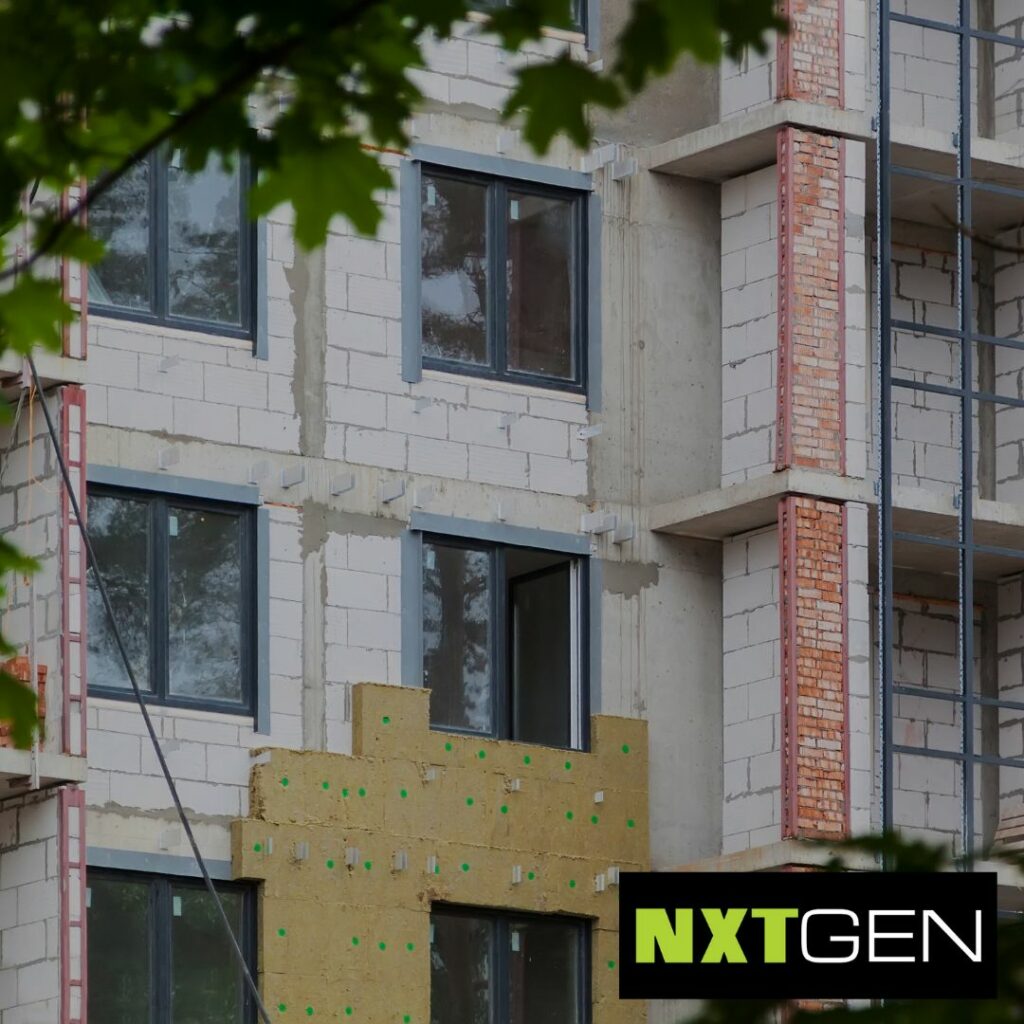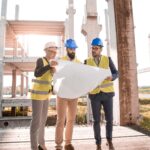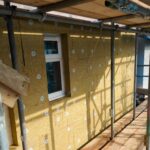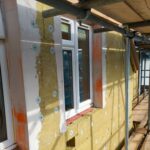In Retrofit by Robert Wheeler / 30 November 2023 / 0 comments

Retrofitting has emerged as a crucial solution for addressing the energy efficiency and sustainability challenges faced by buildings in the United Kingdom. In an era where environmental concerns and rising energy costs have taken centre stage, retrofitting offers a pathway to transform existing buildings into more energy-efficient, comfortable & environmentally friendly structures.
This blog post delves into the concept of retrofit, exploring its significance in the UK context. It examines various retrofitting techniques and technologies, highlights the benefits of retrofitting, and delves into government initiatives and policies. Additionally, this blog post discusses the challenges and limitations of retrofitting, presents successful case studies from the UK, and offers insights into the future outlook and opportunities that retrofitting presents in the country.
Introduction to Retrofit in the UK
What is Retrofit?
Retrofitting in the UK refers to the process of making improvements and upgrades to existing buildings to enhance their energy efficiency and sustainability. It involves implementing various techniques and technologies to reduce energy consumption, improve indoor comfort, and reduce carbon emissions.
The Importance of Retrofitting in the UK
Retrofitting plays a crucial role in addressing the environmental challenges faced by the UK. As buildings account for a significant portion of energy consumption and greenhouse gas emissions, retrofitting offers a practical solution to reduce their environmental impact. By upgrading existing buildings rather than constructing new ones, we can make a substantial impact on reducing carbon emissions, mitigating climate change, and achieving sustainability goals.

The Concept of Retrofit and its Importance
Understanding Retrofitting in the Context of Building Renovation
Retrofitting shouldn’t be mistaken for a simple renovation or remodelling project. While renovation focuses on cosmetic improvements, retrofitting focuses on enhancing the energy efficiency and sustainability of a building. It involves implementing energy-saving measures, such as upgrading insulation, replacing inefficient heating systems, and improving ventilation, among others.
The Significance of Retrofitting in Sustainable Development
Retrofitting plays a vital role in sustainable development. By optimizing the energy performance of existing buildings, we can reduce the reliance on fossil fuels and decrease the carbon footprint. This contributes to the preservation of natural resources and helps create a more sustainable and resilient built environment for future generations.
Retrofitting Techniques and Technologies
Energy Efficiency Measures in Retrofitting
Retrofitting projects often include implementing energy-saving measures such as LED lighting, smart thermostats, and energy-efficient appliances. These solutions help reduce energy consumption and lower utility bills while maintaining or even improving the comfort and functionality of the building.
Insulation and Ventilation Upgrades
Improving insulation and ventilation are crucial aspects of retrofitting. Upgrading insulation helps reduce heat loss during winter and heat gain during summer, leading to reduced energy consumption. Improved ventilation ensures fresh air circulation, maintaining indoor air quality and creating a healthier living or working environment.
Renewable Energy Integration in Retrofit Projects
Incorporating renewable energy sources, such as solar panels or wind turbines, into retrofitting projects can further enhance their sustainability. These technologies generate clean energy and can significantly decrease reliance on National Grid electricity, reducing both environmental impact and long-term energy costs.
Benefits of Retrofitting in the UK
Reduced Energy Consumption and Lower Utility Bills
One of the significant advantages of retrofitting is the potential for reduced energy consumption. By implementing energy-efficient measures, buildings can consume less energy, resulting in lower utility bills for occupants. This helps individuals and businesses save money while contributing to the overall reduction of greenhouse gas emissions.
Improved Indoor Comfort and Health
Retrofitting projects often lead to improved indoor comfort and health. By upgrading insulation, improving ventilation, and optimizing heating and cooling systems, buildings can maintain more comfortable temperature levels throughout the year. Additionally, better air quality resulting from improved ventilation enhances occupant health and well-being.
Enhanced Property Value and Marketability
Retrofitting can increase the market value and marketability of properties. Energy-efficient and sustainable buildings are increasingly sought after by buyers and tenants who value lower energy costs and environmentally friendly features. Retrofitting ensures that a building meets or exceeds modern energy performance standards, making it more attractive and competitive in the UK property market.
Retrofitting in the UK is a win-win situation. It not only helps tackle environmental challenges but also provides economic benefits to building owners and occupants. By investing in retrofitting, we can create a greener, more sustainable future while enjoying the immediate benefits of energy savings, improved comfort, and increased property value. So let’s embrace retrofitting and make our buildings the superheroes of sustainability!
Government Initiatives and Policies for Retrofitting
Overview of Government Support for Retrofitting in the UK
In recent years, the UK government has recognized the importance of retrofitting to improve the energy efficiency and sustainability of existing buildings. Retrofitting refers to the process of upgrading and improving the performance of buildings through various measures such as insulation, energy-efficient heating systems, and renewable energy installations. The government has implemented a range of initiatives and policies to support and encourage retrofit projects across the country.
Incentives and Grants for Retrofit Projects
To incentivize retrofitting, the government provides grants and financial support to homeowners, landlords, and businesses. For instance, the Green Homes Grant scheme offers vouchers to homeowners for energy-efficient improvements, including insulation, double glazing, and heat pumps. Additionally, there are grants available for social housing providers and businesses to undertake retrofit projects. These incentives play a crucial role in making retrofitting more accessible and affordable for a wider range of people.
Building Regulations and Standards for Retrofitting
The government has also introduced building regulations and standards that promote energy efficiency in existing buildings. These regulations outline the minimum requirements for insulation, heating systems, and ventilation in retrofit projects. Compliance with these standards is essential when undertaking retrofitting work to ensure that the improvements meet the necessary energy efficiency criteria. Building regulations help maintain consistency and quality in retrofitting projects throughout the UK.
Challenges and Limitations of Retrofitting in the UK
Financial Constraints and Return on Investment
One of the main challenges of retrofitting is the upfront cost involved. While retrofit projects can bring long-term energy savings, the initial investment can deter some homeowners and businesses. The return on investment may take years to recoup, making it a challenge, especially for those with limited financial resources. However, the government grants and incentives mentioned earlier help mitigate this financial barrier by reducing the upfront costs.
Technological Constraints and Compatibility Issues
Another challenge in retrofitting is the compatibility of new technologies with existing building structures. Retrofitting often requires integrating new energy-efficient systems, such as heat pumps or solar panels, into older buildings. Ensuring that these technologies work harmoniously with the existing infrastructure can be complex. It requires careful planning, engineering expertise, and sometimes modifications to the building fabric. Overcoming these technological constraints is crucial to achieving successful retrofit outcomes.
Disruption to Occupants during Retrofitting
Retrofitting projects can cause inconvenience and disruption to occupants, whether residential or commercial. Depending on the scale and nature of the retrofit work, occupants may need to temporarily relocate or adjust their routines to accommodate the construction process. Noise, dust, and limited access to certain areas of the building during the retrofitting can be inconvenient for those living or working in the premises. Effective communication and project management are essential to minimize disruptions and ensure a smooth retrofitting experience.
Successful Case Studies of Retrofit Projects in the UK
Retrofitting Social Housing for Energy Efficiency
In recent years, there have been successful retrofit projects in social housing estates across the UK. These projects have focused on improving insulation, upgrading heating systems, and installing renewable energy technologies. The aim is to reduce energy bills for residents and create more sustainable housing. By retrofitting social housing, the government and housing associations have made significant progress towards achieving their energy efficiency targets and reducing fuel poverty.
Retrofitting Commercial Buildings for Sustainability
Numerous commercial buildings in the UK have undergone successful retrofitting to improve their sustainability & energy performance. Retrofit measures include upgrading lighting systems, implementing smart building controls, and installing energy-efficient HVAC systems. These projects have demonstrated the financial and environmental benefits of retrofitting for businesses, reducing energy costs and carbon emissions.
Retrofitting Historic and Listed Buildings
Retrofitting historic and listed buildings presents unique challenges due to their architectural significance and conservation requirements. However, successful retrofit projects have shown it is possible to improve the energy efficiency of these buildings while preserving their historic character. These projects often involve careful planning, collaboration with conservation bodies, and innovative solutions that respect the building’s heritage.
Future Outlook and Opportunities for Retrofitting in the UK
Emerging Trends and Innovations in Retrofitting
The future of retrofitting in the UK holds promising trends and innovations. The use of smart technology, such as interconnected building systems and energy monitoring, is becoming more prevalent in retrofits. Additionally, the integration of renewable energy technologies, such as solar panels and heat pumps, is expected to play a larger role in retrofit projects. These advancements will enhance the energy efficiency and sustainability of buildings in a more seamless and user-friendly manner.
Potential for Job Creation and Economic Growth
The scale of retrofitting required in the UK presents significant opportunities for job creation and economic growth. Retrofit projects require a skilled workforce, including architects, engineers, contractors, and energy assessors. The demand for these professionals is expected to increase as the retrofitting industry grows. Moreover, the development and manufacturing of energy-efficient products and technologies associated with retrofitting can contribute to the economy.
Integration of Retrofitting with Net Zero Carbon Goals
Retrofitting plays a vital role in achieving the UK’s net-zero carbon goals. By improving energy efficiency and reducing carbon emissions from existing buildings, retrofit projects directly contribute to decarbonizing the built environment. The government’s commitment to net-zero carbon by 2050 provides a strong incentive for investment and innovation in retrofitting. The integration of retrofitting strategies into national and local climate action plans will be crucial for achieving these ambitious targets.
Conclusion
In conclusion, retrofitting in the UK has become a vital approach to improving energy efficiency, reducing carbon emissions, and enhancing the overall sustainability of buildings. Through the adoption of innovative technologies and the support of government initiatives, retrofitting presents immense benefits, including cost savings, improved comfort, and increased property value. While challenges and limitations exist, successful case studies demonstrate the transformative potential of retrofitting. Looking ahead, the future of retrofitting in the UK holds promising opportunities for continued progress towards a more sustainable built environment. By investing in retrofit projects and embracing the principles of energy efficiency, the UK can pave the way for a greener and more resilient future.
Retrofit in the UK FAQs
Retrofitting in the UK refers to the process of upgrading and improving existing buildings to enhance energy efficiency, reduce carbon emissions, and improve overall sustainability. It involves implementing various measures such as insulation upgrades, energy-efficient appliances, and renewable energy integration to transform buildings into more environmentally friendly and cost-effective structures.
Yes, the UK government offers financial incentives and grants to support retrofitting projects. These incentives aim to encourage property owners and businesses to invest in energy-efficient upgrades. Examples of financial assistance include the Green Homes Grant scheme, which provides vouchers for energy-saving home improvements, and the Renewable Heat Incentive, which offers financial support for the installation of renewable heating systems.
Retrofitting buildings in the UK can come with certain challenges. Financial constraints and upfront costs often deter property owners from undertaking retrofit projects. Compatibility issues with existing structures and systems can also pose technical challenges. Additionally, retrofitting may cause disruption to occupants during the renovation process. However, these challenges can be mitigated through careful planning, expert guidance, and accessing available support and resources.
Retrofitting plays a significant role in helping the UK achieve its sustainability goals. By upgrading existing buildings, retrofitting reduces energy consumption, lowers carbon emissions, and enhances overall environmental performance. It aligns with the country’s commitment to combat climate change and transition towards a net-zero carbon future. Retrofitting also supports the UK’s objectives to improve energy efficiency, enhance occupant comfort and well-being, and create a more sustainable built environment.
Ready to discuss your regeneration project and how NXTGEN Futures Ltd can elevate it with expert retrofit? Contact us today!
Latest Retrofit Posts
- What a retrofit-first approach offers the UKRetrofitting is like giving your home a makeover to make it more energy-efficient, comfortable, and healthy. The retrofit-first approach prioritizes upgrading existing buildings over new construction to tackle climate change and improve living conditions. Definition of Retrofitting Retrofitting involves making… Read more: What a retrofit-first approach offers the UK
- What is internal wall insulation?Internal wall insulation is a crucial component of creating a comfortable and energy-efficient living space. By insulating the walls within a building, homeowners can experience benefits such as improved thermal performance, reduced energy bills, and enhanced acoustic comfort. Understanding the… Read more: What is internal wall insulation?
- What is a retrofit assessor?Retrofit assessors play a crucial role in the sustainability and energy efficiency of buildings by evaluating and identifying opportunities for improvement. This blog post aims to provide an in-depth understanding of the responsibilities, qualifications, and benefits associated with being a… Read more: What is a retrofit assessor?
- What is a retrofit assessment in the UK?Retrofit assessments play a crucial role in the sustainable development of buildings in the UK, helping to improve energy efficiency, reduce carbon emissions, and enhance overall building performance. By evaluating existing structures and identifying opportunities for upgrades and enhancements, retrofit… Read more: What is a retrofit assessment in the UK?
- Retrofit and Energy Efficiency in Historic BuildingsHistoric buildings are not only architectural treasures but also valuable cultural assets that contribute to our sense of history and identity. However, many of these buildings often suffer from poor energy efficiency, leading to excessive energy consumption and high operating… Read more: Retrofit and Energy Efficiency in Historic Buildings
- What is retrofitting in construction?Retrofitting in construction is a crucial process that involves upgrading existing buildings or structures to meet modern standards of safety, energy efficiency, and functionality. This blog post explores the concept of retrofitting, its importance, various techniques used in the industry,… Read more: What is retrofitting in construction?
- CASE STUDY: Curtis WayDelivering a Holistic Retrofit Solution with EWI & Solar Energy Project Overview NXTGEN Futures Ltd. successfully completed a large-scale retrofit project on Curtis Way, Berkhamsted, England, UK. This case study showcases our expertise in External Wall Insulation (EWI), retrofit coordination,… Read more: CASE STUDY: Curtis Way
- What happens to a building during retrofitting?Building retrofitting is a vital process that involves making significant modifications and improvements to existing structures to enhance their efficiency, functionality, and sustainability. In this blog post, we will delve into the intricate workings of building retrofitting, exploring the various… Read more: What happens to a building during retrofitting?
- UK Government Retrofit Scheme: Making Energy Efficiency Cool AgainIntroduction to the UK Government Retrofit Scheme Background of the Retrofit Scheme Picture this: you’re sitting at home, snuggled up in your favourite blanket, enjoying a cup of tea, when suddenly you feel a draft. Not cool, right? Well, that’s… Read more: UK Government Retrofit Scheme: Making Energy Efficiency Cool Again
- What are Retrofit Trickle Vents?Improving indoor air quality and enhancing energy efficiency are key priorities for many homeowners. In this article, we will explore the concept of retrofit trickle vents and their role in achieving these goals. Trickle vents are small, adjustable openings integrated… Read more: What are Retrofit Trickle Vents?
- Retrofit Underfloor HeatingRetrofit underfloor heating has gained significant popularity as a cost-effective and efficient solution for enhancing the comfort and energy efficiency of existing buildings. Unlike traditional radiator systems, underfloor heating distributes warmth evenly across the floor, providing a comfortable and cozy… Read more: Retrofit Underfloor Heating
- Retrofit LondonRetrofitting has emerged as a crucial solution in transforming the landscape of cities, and London is no exception. As a global hub of culture, commerce, and innovation, London faces the pressing challenge of reducing its carbon footprint while ensuring sustainable… Read more: Retrofit London












